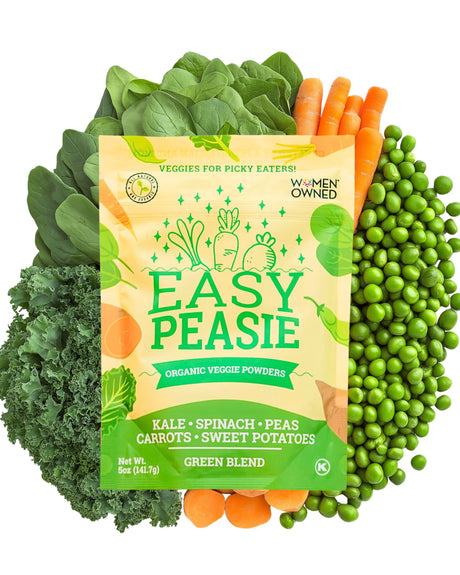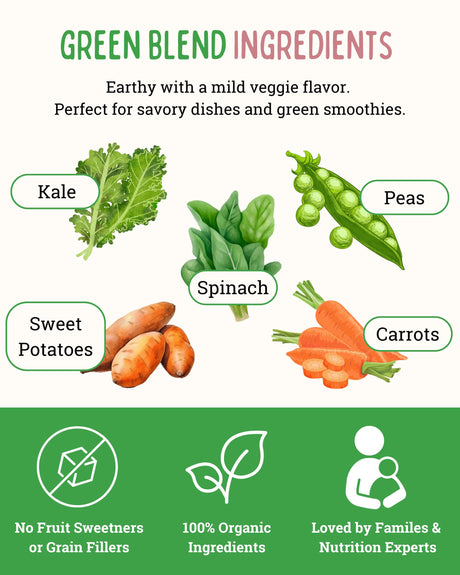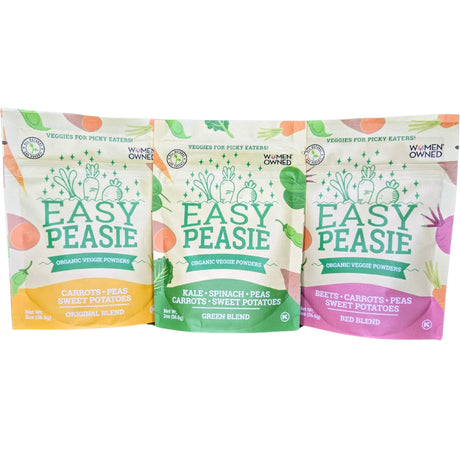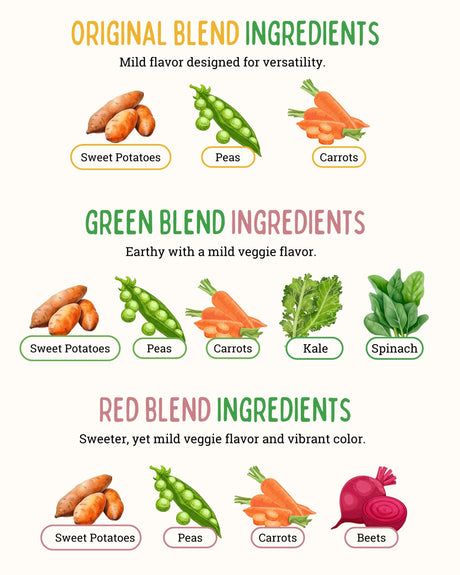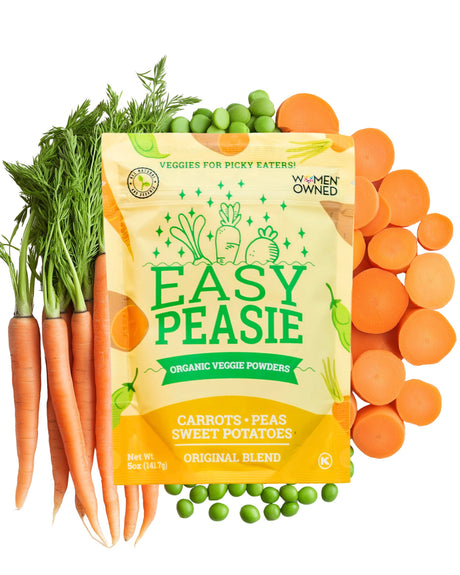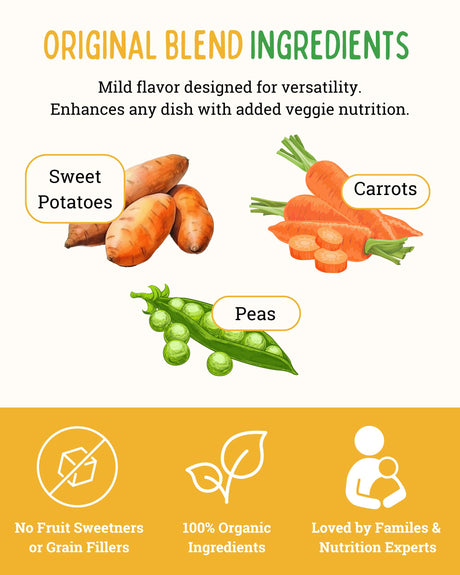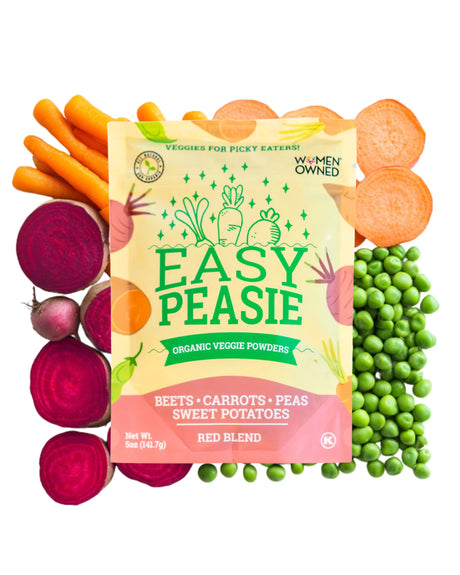Cornerstone of Childhood Nutrition:
Packed with essential vitamins, minerals, antioxidants, and dietary fiber, vegetables play a pivotal role in a child's overall growth, cognitive development, and immune function.
Ensuring a regular intake of these nutrient-dense foods can lay the foundation for a lifetime of healthy eating habits and potentially ward off future health complications.
The Parental Dilemma:
For many parents, the scene is all too familiar: plates with untouched greens, faces scrunched at the sight of vegetables, and the endless negotiations for just one more bite.
Navigating the challenges of introducing and maintaining a vegetable-rich diet can be daunting, especially when competing with the allure of processed, sugary snacks. Understanding these challenges is the first step for parents aiming to make vegetables a cherished part of their children's meals.
Understanding the Nutritional Value of Vegetables:
Vitamins in Vibrant Veggies:
From the vitamin C in bell peppers to the vitamin A in carrots, vegetables are a treasure trove of essential vitamins. These vitamins not only boost the immune system but also play a role in vision, bone health, and skin integrity.
Spinach, for instance, is rich in folate, crucial for DNA synthesis and cell division, especially during the early years of rapid growth.
Mineral Magic:
Beyond vitamins, vegetables are a source of vital minerals like calcium, potassium, and iron. Broccoli and kale, for instance, offer calcium essential for bone development.
Potassium, abundant in sweet potatoes, aids in muscle function and maintaining a healthy blood pressure.
Fiber and Beyond:
Vegetables like peas are rich in dietary fiber, promoting digestive health and keeping those childhood tummy troubles at bay. Fiber also plays a role in maintaining healthy blood sugar levels, crucial in preventing early onset of lifestyle diseases.
Building Blocks of Growth:
The nutrients in vegetables are integral to various bodily functions. For instance, the iron in spinach aids in oxygen transport, ensuring active kids have the energy they need to explore, play, and learn. The antioxidants in veggies like tomatoes combat free radicals, supporting overall cellular health and immunity.
A Foundation for the Future:
Incorporating a diverse range of vegetables provides children with a spectrum of nutrients, each playing a unique role in their growth and development. By understanding the nutritional powerhouse that vegetables are, parents can appreciate the long-term benefits they offer, setting the stage for a lifetime of health and well-being.
Breakfast: A Veggie-Infused Start
Sip Your Greens: Vegetable-Based Smoothies:
Starting the day with a smoothie is not only quick but also a sneaky way to get in those veggies. Think beyond the usual fruit combinations. Spinach pairs beautifully with blueberries, and carrots with oranges.
Add a handful of kale to your mango smoothie for an extra nutrient punch. With the right blend, even the most discerning little taste buds won't detect the veggies.
Eggs with a Veggie Twist:
Eggs are a breakfast staple, and what better way to elevate them than with a sprinkle of veggies? Whether it's bell peppers in your omelet or brocolli in your scrambled eggs, these additions not only enhance flavor but also pack in nutrition.
A spinach and feta omelet or a tomato-basil scramble can make mornings delightful and nutritious.
Baked Delights: Vegetable Muffins and Pancakes:
Who said muffins and pancakes are only about sweetness? Grated zucchini or finely chopped spinach can easily find their way into your muffin batter.
Carrot pancakes drizzled with a touch of honey can be a hit. These baked goods offer a comforting warmth, with the added benefit of veggies, making them a win-win for both taste and health.
Lunch: Veggie-Packed Meals for Midday
Wrap It Up: Vegetable Wraps and Sandwiches:
Lunch wraps and sandwiches don't have to be mundane. Think colorful bell pepper strips, crunchy lettuce, and creamy avocado in a whole grain wrap. Or perhaps a sandwich with roasted veggies, a smear of hummus, and a sprinkle of feta.
These combinations not only provide a burst of flavor but also ensure a midday meal that's rich in nutrients.
Not-So-Boring Greens: Salads Kids Will Love:
Salads can be fun, especially when they're vibrant and interactive. Ditch the plain lettuce and tomato combo. Instead, opt for rainbow salads with cherry tomatoes, yellow bell peppers, and purple cabbage.
Add a sprinkle of cheese or a handful of nuts, and serve with a fun dressing on the side. Letting kids mix their own salad can make the experience more engaging.
Comfort in Every Bite: Veggie-Loaded Pasta and Rice Dishes:
Pasta and rice are comfort foods, and they offer a perfect canvas for veggies. A spaghetti dish with a tomato sauce loaded with finely chopped veggies or a stir-fried rice with an array of colorful vegetables can be both satisfying and nutritious.
These dishes ensure that kids get their carbs while also benefiting from the goodness of vegetables.
Snack Time: Veggie Snacks on the Go
Dip and Crunch: Veggie Sticks with Dips:
Snack time can be both fun and nutritious with a colorful array of veggie sticks. Think carrots, cucumbers, and bell peppers, all waiting to be dunked into a creamy hummus or a tangy yogurt dip.
These dips not only elevate the taste but also add an extra layer of nutrition, making it a win-win for parents and kids alike.
A Crispy Delight: Vegetable Chips and Crisps:
Move over potato chips, and make way for veggie crisps! Be it beetroot, zucchini, or sweet potato, these vegetable chips are a crunchy delight. They offer the same satisfaction as regular chips but come packed with the natural goodness of vegetables.
Just remember to check the label for added salts and preservatives if you're buying them off the shelf.
Pizza, But Make It Mini: Mini Vegetable Pizzas:
Who can resist the allure of pizza? Especially when they're mini and loaded with veggies. Use a whole grain base, spread some tomato sauce, and top it off with diced vegetables of your choice.
Sprinkle some cheese, bake until golden, and voila! You have a snack that's both delicious and veggie-packed, ready to be devoured.
Dinner: Making Veggies the Star
Sizzle and Spice: Vegetable Stir-Fries and Curries:
The sizzle of fresh vegetables hitting a hot pan is music to many ears. Stir-fries, with their quick cooking method, retain the crunch and freshness of vegetables, making them a delightful dinner option.
Add in some tofu or chicken, a splash of soy sauce, and you have a meal that's both tasty and nutrient-rich. On the other hand, curries offer a warm, aromatic embrace to vegetables. Whether it's a creamy coconut curry or a spicy tomato-based one, vegetables soak up all the flavors, turning into melt-in-the-mouth delights.
Comfort in a Dish: Incorporating Vegetables into Casseroles and Stews:
There's something inherently comforting about casseroles and stews, especially on a chilly evening. Vegetables, when slow-cooked in these dishes, become tender and imbued with the flavors of herbs and spices.
Think of a broccoli and cheese casserole or a hearty vegetable and bean stew. These dishes are not just comfort food; they're also a great way to pack in a variety of vegetables in a single meal.
A Bowl of Goodness: Veggie-Based Soups:
Soups are versatile, filling, and a fantastic way to make vegetables the star. From a creamy pumpkin soup to a rustic vegetable broth, the options are endless. The best part? You can puree them for a smooth texture or leave them chunky, catering to different preferences.
Pair with some crusty bread, and you have a dinner that's both wholesome and satisfying.
Desserts: Yes, Veggies Can Be Included!
Creamy Delights: Vegetable-Based Ice Creams:
Who would've thought veggies could make their way into our ice cream bowls? But they do, and with a delightful twist! Avocado ice cream, for instance, is a creamy dream, with its rich texture and subtle flavor. It's a healthier alternative that doesn't compromise on taste.
Sweet potato, with its natural sweetness, also makes for a delectable ice cream base. These veggie-infused ice creams not only satisfy our sweet cravings but also add a nutritional punch to our desserts.
Indulge Without the Guilt: Veggie-Packed Brownies and Cookies:
Imagine biting into a brownie and knowing it's packed with the goodness of zucchini or beetroot. Sounds too good to be true? Well, it's not. Vegetables can be sneaked into brownies and cookies, adding moisture and nutrients without altering the beloved flavors of these treats.
Beetroot brownies or spinach cookies might sound unconventional, but they're delicious and a hit among both kids and adults.
Refreshing Bites: Fruit and Vegetable Popsicles:
When the sun's blazing, there's nothing like a refreshing popsicle to cool down. And what if that popsicle was loaded with the goodness of fruits and vegetables?
Cucumber and watermelon or carrot and orange popsicles are not just refreshing but also a sneaky way to get those veggies in. These popsicles are a testament to the fact that vegetables can be fun and delicious, even in a dessert!
Tips for Making Vegetables Appealing
A Feast for the Eyes: Colorful Vegetable Platters:
We eat with our eyes first, and this couldn't be truer when it comes to kids. Incorporating a rainbow of vegetables on the plate not only ensures a variety of nutrients but also makes the meal visually enticing.
Think bright bell peppers, deep purple eggplants, sunny yellow corn, and vibrant green broccoli. These colorful additions can transform even the simplest of dishes into something more inviting.
Little Chefs in the Making: Kids in the Kitchen:
There's something magical about letting kids take charge in the kitchen. When they're involved in the process, from washing and chopping to stirring and seasoning, they're more likely to be curious about the end result.
Letting them sprinkle some cheese on their veggie pizza or stir the pot of vegetable soup can make a world of difference in their willingness to try what they've helped create.
Vary to Satisfy: Experimenting with Cooking Methods:
Vegetables can take on entirely different flavors and textures depending on how they're cooked. Roasting brings out the natural sweetness in veggies like carrots and Brussels sprouts. Grilling can add a smoky flavor to zucchini or asparagus, making them taste entirely different from their steamed counterparts.
And speaking of steaming, it's a method that retains the crunch and vibrant color of veggies, making them a hit, especially among the younger crowd. By switching up cooking methods, you can introduce a variety of tastes and textures, keeping the veggie experience fresh and exciting.
Overcoming Challenges
The Veggie Veto: Why Kids Say No:
It's a tale as old as time - the plate is full, but the little green trees (broccoli) remain untouched. Children, with their developing taste buds, can sometimes find the flavors of certain vegetables too strong, bitter, or simply unfamiliar. It's essential to understand that this rejection isn't always about defiance; it's often about taste, texture, or past experiences.
Picky Eaters: It's Not About the Veggies:
Dealing with a picky eater can feel like navigating a minefield. One day they love carrots, and the next, they act as if it's their arch-nemesis. The key is not to turn mealtime into a battleground. Instead, offer choices, make veggies fun, and avoid making separate meals.
Remember, it's okay if they don't love every vegetable. The goal is exposure, not force.
Repetition, Repetition, Repetition: Cultivating a Veggie Love:
Ever heard the saying, "Familiarity breeds liking?" It's especially true for vegetables. A child might need to be exposed to a vegetable up to 15 times before they start to like it. It's all about repetition. Keep introducing the veggies in various forms, textures, and flavors.
Over time, with consistent exposure, their palate will begin to recognize and even appreciate the flavors they once rejected.
Final Thoughts
The Veggie Imperative:
Vegetables, with their rich array of nutrients, play a pivotal role in laying the foundation for a child's health. They're not just side dishes to be pushed around on a plate; they're the building blocks of growth, development, and overall well-being.
Making them a regular part of a child's diet isn't just about today's meal; it's about setting the stage for lifelong health.
Patience and Persistence: The Parenting Mantra:
Every parent knows that raising kids comes with its fair share of challenges, and mealtime is no exception. But remember, every small victory counts. Whether it's a single bite of broccoli or a newfound love for spinach, celebrate it.
Be patient, be persistent, and know that with time and consistent effort, you're paving the way for a healthier future for your child.


